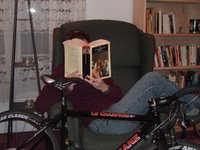So you know how I thought the introduction to my edition of Dracula was funny? Well, the footnotes are funnier. I’m discovering that my edition isn’t a typically academic one; in fact, I think it’s geared more toward gothic/horror fans, although the book proclaims the editor as “the world’s premier Dracula scholar” (which reminds me of Little Miss Sunshine …).
The edition has commentary by “leading contemporary horror writers, including Harlan Ellison, Robert Bloch, and many more” and this commentary is interspersed throughout the book, so that in between chapters I’m invited to step outside of the story and think about what some other writer has to say about it. Actually, though, I just ignore those parts. The book also has “Over 35 illustrations, including stunning new Dracula illustrations by Christopher Bing.” These are fun, but I was a bit perplexed to come across a drawing of Bram Stoker himself – again, it’s disconcerting to get caught up in a story and then get pulled out of it to consider what the author looks like. Why couldn’t they just let the story be, and keep all that other stuff to the introduction or an appendix?
But the footnotes are the most intrusive of all; they are frequent, with probably 3 or 4 a page on average and often lengthy. Many of them contain useful information – a LOT of information – on the history and culture of Transylvania, on vampire stories, on Stoker’s life and times. But many of them contain no useful information at all, and instead offer interpretations of the book, point out inconsistencies in Stoker’s storytelling, make judgments on the characters’ actions, and generally just get in the way – and make me laugh. The book mentions the dish “paprika hendl,” and in the footnotes we get a recipe. The novel says that the driver “cracked his big whip over four small horses, which ran abreast,” and the footnote tells us “In no Dracula film yet made has anyone depicted the horses harnessed in this way.”
Dracula says, “I love the shade and the shadow, and would be alone with my thoughts when I may,” and the editor muses, “A surprisingly melancholy passage. Is Dracula lonely? Why does he want Harker there? Is he really testing his English, or his social skills, as he claims?” And what are these footnotes – attempts at creating a reader’s guide, complete with discussion questions? Harker considers escaping from Dracula’s castle, saying, “I shall try to scale the castle wall farther than I have yet attempted. I shall take some of the gold with me lest I want it later,” and the editor gets moralistic: “A pretty lame excuse for stealing Dracula’s gold.”
But the best footnote of all is yet to come (and I’ve only read about 60 pages! Hundreds left to go!). First, the text: this is the scene where Harker is first attacked by the three mysterious vampire women hanging out in Dracula’s castle (and the text itself is pretty funny, if you read it in the right way):The girl went on her knees, and bent over me, simply gloating. There was a deliberate voluptuousness which was both thrilling and repulsive, and as she arched her neck she actually licked her lips like an animal, till I could see in the moonlight the moisture shining on the scarlet lips and on the red tongue as it lapped the white sharp teeth. Lower and lower went her head as the lips went below the range of my mouth and chin and seemed about to fasten on my throat. Then she paused, and I could hear the churning sound of her tongue as it licked her teeth and lips, and could feel the hot breath on my neck….
Here’s the accompanying footnote:I have tried, calmly as well as passionately, to reproduce this churning sound with my tongue but without success. It may be a noise that only a passionate vampire can make.
I’m glad to know this editor is doing his research!
It would be better to read a less intrusive edition for my first time through the book, but I have to admit that the editorial apparatus is adding an entirely unexpected level of pleasure to my reading.
Tuesday, September 12, 2006
Footnotes
Posted by
Rebecca H.
at
7:28 AM
![]()
Subscribe to:
Comment Feed (RSS)



|